Cranberries are a staple at millions of holiday tables. These tart berries appear most often in the form of cranberry sauce. Americans consume five million gallons of this tart berry sauce during the holidays each year. But where do all those cranberries come from? Mostly, they come from the United States. The U.S. is the world’s leading producer of cranberries by a wide margin. Canada and Chile are the next biggest producers, but their combined yields do not equal the annual cranberry production of the U.S. Just five states produce most all U.S. cranberries. Here’s a look at cranberry cultivation in the U.S., including the top five states that grow the most cranberries.
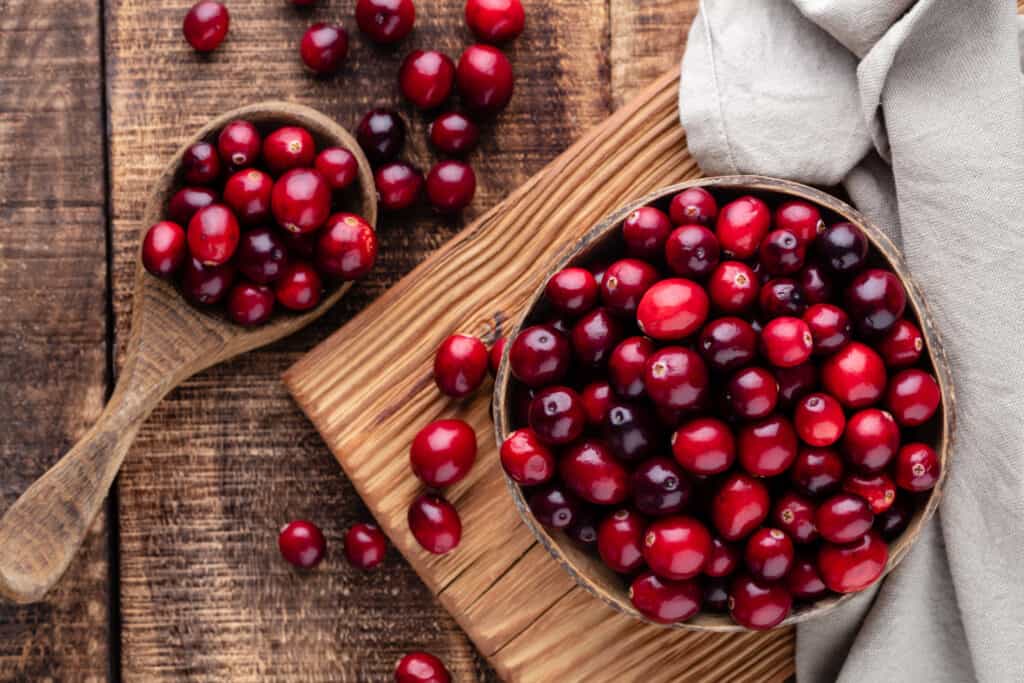
Cranberries are a mainstay at American holiday meals.
©iStock.com/gitusik
Native Fruit
The cranberry is a native North American fruit. Its native range extends from the east coast to the central United States and Canada, stretching from southern Canada in the north to the Appalachians in the south.
Here are the top five states for cranberry production in the United States.

1. Wisconsin
Wisconsin produces 61% of all U.S. cranberries. Notably, in 2003, state lawmakers designated the cranberry as Wisconsin’s state fruit, thanks to the lobbying efforts of a group of fifth-graders.
Cranberries originate from the marshlands of central Wisconsin. Native Americans used them for food, medicinal remedies, and poultices for centuries before European settlers set foot on the land. They also made dye from these vibrant red berries to color rugs and blankets.
Cranberry farming in Wisconsin began in the 1830s. By the mid-1950s, Wisconsin had risen to become the second-largest U.S. cranberry producer, only behind Massachusetts. However, by 1994, Wisconsin overtook Massachusetts to become the top cranberry producer.
Currently, about 270 farms in Wisconsin grow cranberries. These farms span around 21,000 acres across 20 of Wisconsin’s 72 counties, mainly in the central and northern regions.
In 2023, Wisconsin aims to harvest 4.97 million barrels of cranberries, a growth from 2022’s 4.84 million barrels. Cranberry production contributes almost one billion dollars to Wisconsin’s economy per year.
Wisconsin’s nearly 30-year run as the leading cranberry producer in the U.S. shows no signs of stopping anytime soon.

Wisconsin cranberry bogs, such as this one, yield almost five million barrels of cranberries each year.
©KLBahr/ via Getty Images
2. Massachusetts
Massachusetts was the nation’s leading producer of cranberries before Wisconsin supplanted it. Today, the Bay State is the second-largest cranberry-producing state in the U.S. Massachusetts produces around two million barrels of cranberries per year, accounting for roughly 26% of U.S. cranberry production. More than 14,000 acres in Massachusetts are dedicated to cranberry cultivation. Cranberries are the top food crop in Massachusetts, with an annual crop value of $73.4 million.
Cranberries are native to Massachusetts. Cranberry cultivation began on Cape Cod, with the first recorded cranberry cultivation in Dennis, Massachusetts, in 1816.
Most of Massachusetts’ cranberries are still grown in the Buzzards Bay region, with some 8,000 acres of cranberry bogs throughout the area. There is a higher density of cranberry bogs in the Buzzards Bay region than in any other coastal area in the world.
Ocean Spray, one of the most familiar companies in the cranberry industry, was formed in 1930 in Hanson, Massachusetts. Today, Ocean Spray Cranberries, Inc. is a cooperative of more than 700 cranberry growers in the United States, Canada, and Chile. The cooperative produces 70% of the world’s cranberries. Ocean Spray’s headquarters is located in Plymouth County, Massachusetts.
Like Wisconsin, Massachusetts has also given the cranberry official recognition. Cranberry juice became the official state beverage of Massachusetts in 1970. After two years of lobbying by elementary school students, the cranberry became the official state berry in 1994. Then, in 2005, Massachusetts named its official state colors: blue, green, and, of course, cranberry.
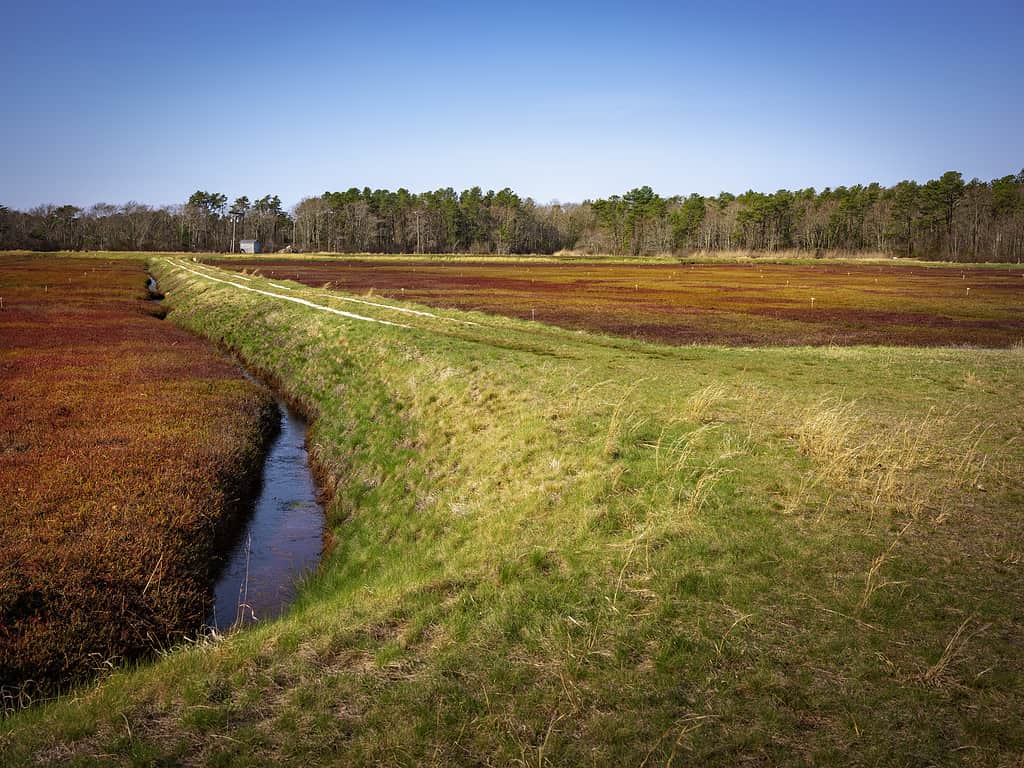
Cape Cod, where this bog is located, is where Massachusetts cranberry cultivation began.
©Sanghwan Kim/ via Getty Images
3. Oregon
Oregon grows around seven percent of U.S. cranberries. The Beaver State’s humid climate and foggy nights create ideal conditions for cranberry growth. Due to its mild autumn weather and relatively late frost, Oregon has a longer growing season than other cranberry-producing states. This extended growing season makes Oregon cranberries less acidic and gives them a darker red color. It also gives the berries a higher natural sugar content, meaning less sugar additions to juice or other products made with Oregon cranberries.
Northwest Oregon is the native home of cranberries. Yet, most of Oregon’s cranberries now flourish in the state’s southwest. Specifically, the Bandon area along the Pacific coast is responsible for producing 95% of Oregon’s cranberry yield. This region boasts about 1,600 acres solely dedicated to cranberry farming. Given the cranberry’s significance to Bandon’s culture and economy, the town honors this berry with its annual Bandon Cranberry Festival. This three-day celebration takes place every second weekend in September and has been a cherished tradition since 1947.
Commercial cranberry farming in the Bandon region traces back to the 1890s. The journey began with Charles McFarlin, a gold seeker. When his golden dreams didn’t pan out, he relocated to Coos County. There, he planted cranberry cuttings he’d brought from Massachusetts. McFarlin and many who followed discovered the coastal environment of southwest Oregon was perfect for nurturing these vibrant red berries.

Oregon has a perfect climate for cranberry cultivation.
©Teri Wertman/ via Getty Images
4. New Jersey
Cranberries are native to the Pine Barrens in New Jersey. The berries have been commercially grown in the state since the 1840s. The Garden State produces around 590,000 barrels of cranberries each year. Almost all of the cranberries harvested in the state are sold to Ocean Spray.
Cranberry farming began in New Jersey in 1835. The state’s first cranberry bog was near Burrs Mills in Burlington County. Other bogs soon followed. Today, some of the first cranberry farms in New Jersey are still operated by descendants of the original owners.
A New Jersey cranberry farmer named Elizabeth Lee created a canned cranberry sauce in 1917. Later, she joined Marcus Urann of Massachusetts, who started a cranberry company in 1912. Together, they formed the Ocean Spray company.
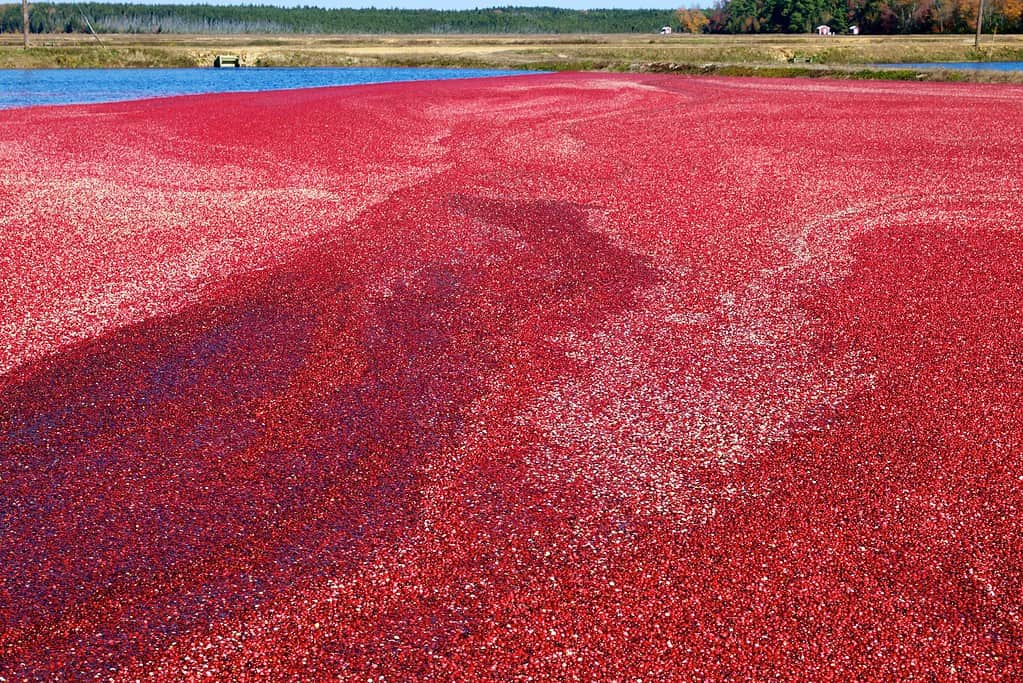
New Jersey cranberry bogs are flooded each fall to harvest the berries.
©JanaShea/ via Getty Images
5. Washington
The first successful cranberry bog on Washington’s Long Beach Peninsula was planted by Anthony Chabot in the 1880s. Chabot was from Massachusetts and noted how similar the peninsula was to Cape Cod. He thought that, since cranberries thrived on Cape Cod, they could also do well on the Long Beach Peninsula.
Chabot’s nephew, Robert Chabot, started a bog in Grays Harbor County in the 1890s. It was the first bog in Washington that was not located on the peninsula.
Today, Washington produces around 200,000 barrels of cranberries each year, accounting for around three percent of the total U.S. crop. There are three cranberry-growing regions in Washington: the Long Beach Peninsula (Pacific County), Grayland (Pacific and Grays Harbor Counties), and Lynden (Whatcom County) regions. The Cranberry Museum is located on the Long Beach Peninsula, memorializing and celebrating the long history of cranberry farming in Washington.
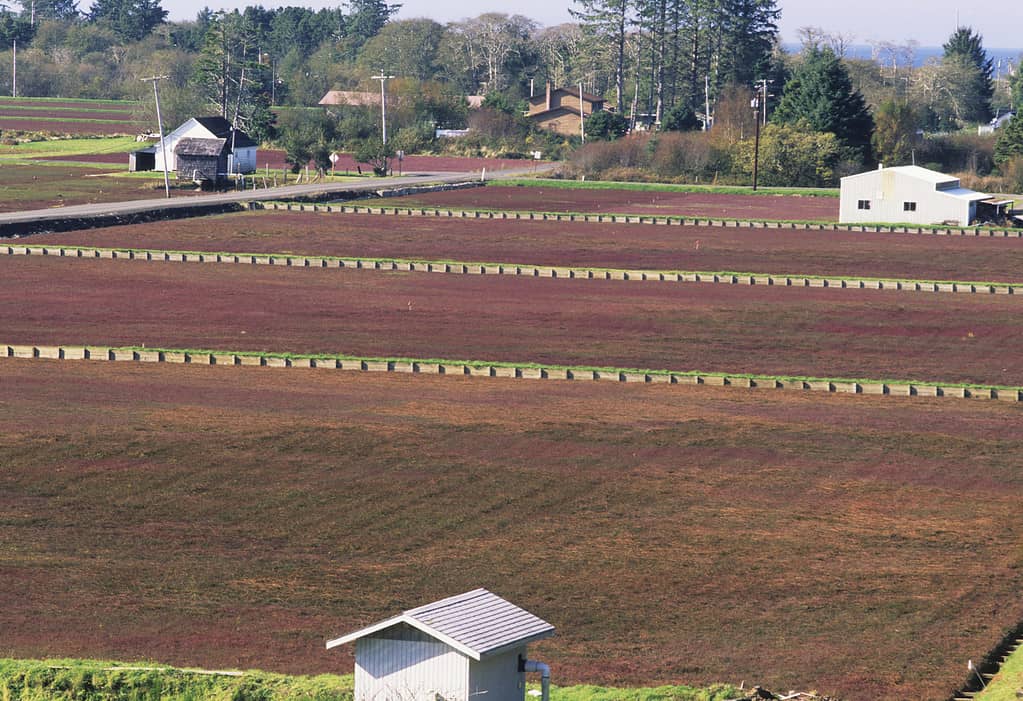
Washington State is the fifth-largest cranberry producer in the U.S.
©PhilAugustavo/ via Getty Images
U.S. Cranberry Exports
About one-third of U.S. cranberries are exported. Some of the top markets for U.S. cranberries include the European Union, the United Kingdom, China, Mexico, South Korea, and Latin America.
Colombia is among the fastest-growing markets for U.S. cranberries. Cranberry consumption in Colombia increased around 80% from 2018 to 2022. The tropical nation’s climate will not support cranberry cultivation, so Colombians’ newfound love of cranberries can only be supported through the importation of berries.
Cranberry Cultivation
A common misconception is that cranberries grow underwater. Actually, they grow in sunken beds layered with sand, peat, gravel, and clay. These plants thrive in wet, sandy, acidic soil.
Low-growing, trailing, woody vines produce cranberries and create a dense mat over the cultivation bed. New vines, when planted, usually take between three to five years to yield berries. But, once these perennial vines take root, they can fruit for many years. In fact, some cranberry plants, over a century old, continue to produce berries consistently every year.
Small pink flowers form on the plants in early summer. Cranberries depend on pollinators such as bees. After the flowers are pollinated, the berries begin to form. The berries start out green. They turn white by late summer, and then they take on their familiar dark red color when they mature in early fall. Cranberries that don’t receive adequate sunlight may remain white even at harvest.
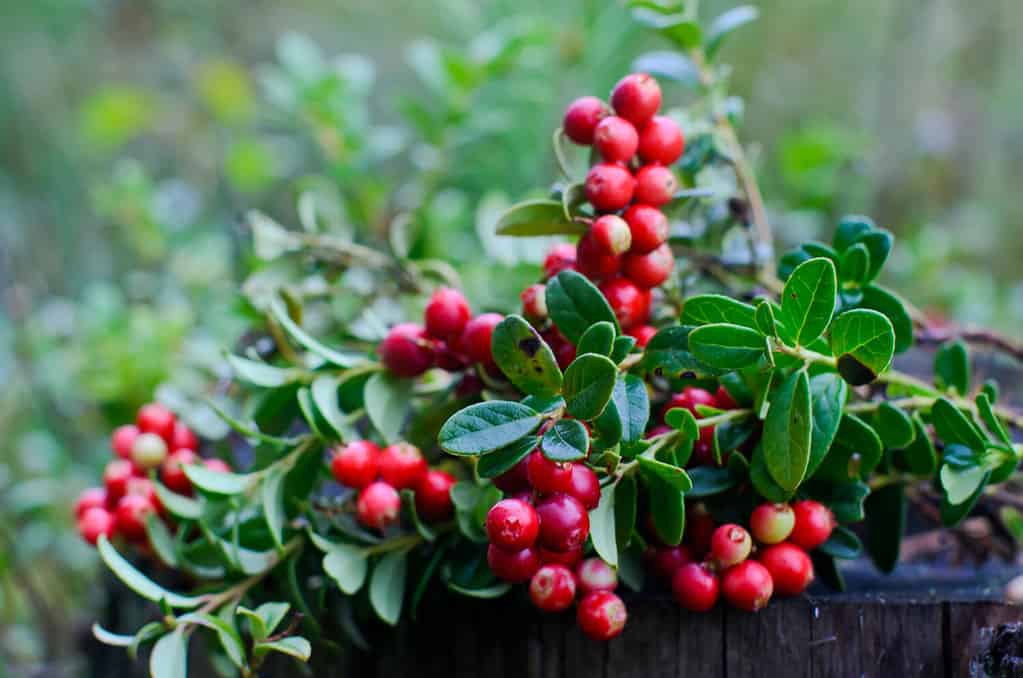
Cranberries grow on woody vines.
©Natalia Korshunova/Shutterstock.com
Harvesting Cranberries
The cranberry harvest is in the fall, typically from mid-September until around mid-November. The extended season in Oregon means that the harvest can last into December.
Cranberries are harvested in two ways: dry harvest and wet harvest. Dry-harvested cranberries are picked with mechanical pickers. Most fresh cranberries are picked using the dry harvest method.
Wet harvesting is more common than dry harvesting. In this method, the cranberry bog is flooded. A machine known as a beater rolls through the bog and separates the cranberries from the vines. Once the berries are removed from the vines, they rise to the top of the water. Cranberries float because each berry contains natural air pockets. Farmers then wade into the bogs and corral the berries, pushing them toward a conveyor that loads them into a truck.
Cranberry bogs are also flooded during the winter. The water protects the plants from the frosty weather.

Wet harvesting involves flooding a cranberry bog and then corralling the floating berries.
©kongxinzhu/ via Getty Images
Health Benefits of Cranberries
Cranberries are a “superfood” due to their many health benefits. The berries are very high in antioxidants. There are more antioxidants in cranberries than almost any other fruit or vegetable. They are also high in anthocyanins, which give the berries their dark red color.
Studies have shown that cranberries may have anti-inflammatory and anti-cancer effects. They may also lower blood pressure, improve cardiovascular health, protect against liver disease, and improve eyesight. Cranberries also may promote urinary tract and gut health.
One cup of raw cranberries contains about 50 calories and provides 25% of the daily recommended dose of vitamin C. Sailors would often consume cranberries to ward off scurvy.
13 Fun Facts About Cranberries
1. Cranberries are almost 90% water.
2. Native Americans combined crushed cranberries with dried venison and melted fat to make pemmican, a high-protein food with a long shelf life.
3. The name “cranberry” dates back to German and Dutch settlers who thought the flower of the plant resembled the neck, head, and bill of a crane. They started calling the fruit of the plant “crane berries.” Over time, the name was shortened to cranberry.
4. Early American settlers purportedly produced The first cranberry juice in 1683.
5. Each year, the average U.S. resident eats 2.3 pounds of cranberries, most of which come in the form of juice or juice blends.
Thanksgiving
6. Americans consume one-fifth of all U.S.-grown cranberries on a single day: Thanksgiving. While many believe cranberries featured in the first Thanksgiving in October 1621, no one knows their exact preparation. The cranberry stands as one of the six iconic symbols of Thanksgiving, alongside the turkey, cornucopia, corn, pumpkin, and beans.
7. Fresh whole cranberries make up only five percent of the U.S. crop sales. Manufacturers use the bulk, 95%, to produce dried cranberries, sauces, juices, and various other cranberry-based products.
8. It takes approximately 200 cranberries to fill one can with cranberry sauce.
9. Cranberries are good for dogs in limited quantities.

Cranberries are a healthy treat for dogs.
©iStock.com/Liliya Kulianionak
Bouncing Berries
10. When ripe, cranberries bounce, earning them the nickname “bounce berries.” The berry’s firm skin encapsulates air pockets, much like an inflated basketball. This causes the berry to bounce if dropped on a hard surface. A New Jersey cranberry grower, John “Peg-Leg” Webb, reportedly made this discovery. Because of his wooden leg, Webb couldn’t carry his cranberries down from his barn loft. So, he opted to pour them down the steps. In doing so, he observed that the freshest and most robust berries bounced all the way to the bottom. This observation inspired the creation of the cranberry bounce board separator, a tool still in use today to distinguish and discard inferior berries.
11. The United States, Canada, and Chile together produce 97% of the world’s cranberries. Since Chile is in the southern hemisphere, the cranberry harvest lasts from March until May.
12. A berry is a fruit that forms from one ovary of a single flower. By this definition, the cranberry is a true berry. Blueberries are also true berries. The botanical definition of a berry also includes some fruits that we would not readily recognize as berries, such as grapes, bananas, cucumbers, eggplants, and tomatoes. Interestingly, strawberries, blackberries, and raspberries are not true berries.
13. There was a 1990s alternative rock band from Limerick, Ireland, known as The Cranberries. Their hits included “Dreams,” “Zombie,” “Salvation,” and “When You’re Gone.” Interestingly, the band’s original name was The Cranberry Saw Us, a word pun that sounds like “cranberry sauce.”
Summary of Top 5 U.S. States That Grow the Most Cranberries
| Rank | State | % of U.S. Cranberry Production | Cranberry Farm Acreage | Barrels Produced 2022/2023 |
|---|---|---|---|---|
| 1. | Wisconsin | 61% | 21,000 acres | 4.84 million |
| 2. | Massachusetts | 26% | 12,000 acres | 2 million |
| 3. | Oregon | 7% | 2,800 acres | 470,000 barrels |
| 4. | New Jersey | Unknown | 2,700 acres | 590,000 barrels |
| 5. | Washington | Unknown | Unknown | 200,000 |
The photo featured at the top of this post is © KLBahr/ via Getty Images
Thank you for reading! Have some feedback for us? Contact the AZ Animals editorial team.






